Tattoos of Sub-Saharan Africa
Article © 2010 Lars Krutak
NIGERIA
The Fang
The Fang are a forest-dwelling people who live in area of 112,500 square miles spread across the international boundaries of Cameroon, Gabon, the Congo, and especially Equitorial Guinea. Scholars believe that the current homeland of the Fang was reached in the 18th century as Muslim Fulbe (Fulani) and Sudanese tribes of central Cameroon pressured them to move southward from their ancestral domains.
In the 1950s, the eminent Catalan primatologist Jordi Sabater Pi (1922-2009) began documenting the tattooing practices of the Fang which later led to a beautifully illustrated work co-authored and co-designed by his son Oriol in 1992. Two drawings from this book are reproduced here.
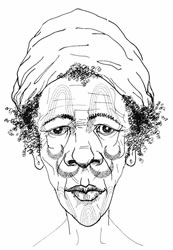
|
|
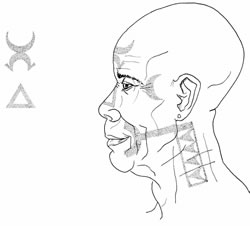 |
| Tattooed Okak Fang woman with “monkey designs” (osó-bom) on cheeks/below nose, “yucca leaf soup” (mendgim mendjà) motif on chin, and assú pattern on forehead, 1954. Illustration © Jordi Sabater Pi. |
|
Tattooed Ntum Fang man with moon crescents on forehead (efà ngon), “monkey design” (ekob kueiny) on nose, and “spearhead” (king-koro) pattern on the neck, 1956. Illustration © Jordi Sabater Pi. |
In the early 1950s, Fang tattooing was already in decline and Sabater recorded many ancient patterns that were only seen on the faces and bodies of the very old. His record of body art remains unparalleled because he witnessed the last generation of tattoo bearers that are no longer living today.
Sabater wrote that the Fang, who probably originated from the vast savannas of the north, looked upon the dense forests of Equitorial Guinea as a mysterious place “full of dangers and the temporary residence of good or evil spirits of ancestors incarnated in certain trees and animals.” But just as the jungle could be dangerous, it also served as the primary source of aesthetic inspiration in the tattooing arts of the Fang people.
|
|
Sabater interviewed and illustrated hundreds of tattooed Fang elders in the 1950s, but even at that time many of his informants could not recall the precise meanings of the marks they wore. They were simply “traditional” or imitations of particular animals that dwelled in the jungle. Sabater speculated that originally the tattoos of the Fang were possibly created “as a response to the need for identification or totemic protection.” |
The Fang practiced two types of tattooing: relief tattoos (mamvam) that were a form of pigmented scarification, and flat tattoos (mevale) that were pricked with a comb-like tool into the skin. The former variety of adornment was already quite rare in Fang territory when Sabater began his investigations, but he was able to study old 19th century reliquary sculptures that were decorated on the chest and abdomen with special tattoos dedicated to ancestor worship. These forms of statuary were used as guardians to
protect the baskets containing the bones and skulls of venerated ancestors and have always been amongst the most admired and sought after genres of African art. |
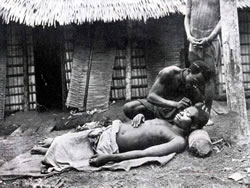
Fang tattooing scene, ca. 1907-1909. |
Several of Sabater’s informants recalled how the process of mamvam and mevale worked:
With [a] small knife in the form of a tiny ndong fish hook the tattoo artist took strong hold of the skin of the subject, which he then cut with the okengeng or tattoo knife; next the artist rubbed the stinging ondondó fluid into wounds to slow down the healing process until a protruding relief tattoowas formed.
Ancient legend tells that it was a blacksmith, from the Essakunan clan, who taught the technique of the flat or puncture tattoo to the Mobum [Fang subtribe], and it was later learnt by the Ntum, the Okak and the Fang-Fang [all southern Fang subtribes].
The Ntum knew the flat puncture tattoos by the name of mevale; the tattoo artist (nkeelekut) covered the face or body of the [client] with kaolin or ash known by the name of nkana; immediately afterwards he traced the outline of the future tattoo by puncturing the skin with several bamboo prongs tied together in the form of a comb and soaked in black soot (nviri-otu). Once this had been done, he would then apply a first coat of the remainder of the nviri-otu to the bleeding cuts.
The ethnologist Günther Tessman witnessed several tattooing sessions during his early Fang Expeditions (1907-1909) and also photographed them. He said that particular clans specialized in tattooing and that “only one in hundreds of men” were skilled enough to perform it. Many of these men were long remembered as masters of their art decades after they had died.
He continued that the operation of knife-cut tattooing was performed in the village meeting house without ceremony, and the patient sat or reclined while receiving their marks. The pigment (otu) was obtained from burning wood and collecting the soot on a pot shard that was placed over the smoking fire. The artist drew a stencil on the part of the body to be tattooed with a wet and curved piece of local grass, leaf stems of the umbrella tree (musanga), or he dipped his finger in the soot and carefully delineated the desired motif. Before dawn, the tattooist began puncturing his client by making short and small cross-cutting and transverse incisions with what Tessman called an endolo – or handle-less iron knife. The artist wiped away any excess blood and rubbed in still more otu pigment with his thumb or forefinger. In other instances, a powder made from the seeds of the Xylopia aethiopica was vigorously rubbed into the wounds. This tree is a tropical evergreen bearing pungent, aromatic seeds still used today as a food condiment and folk medicine in West Africa. |
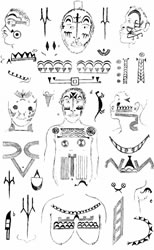 |
| Fang tattoo designs, ca. 1907-1909. |
After the cutting was complete, the body was washed to remove residual blood and soot. Then, another layer of pigment was rubbed into the clean wounds to make the color darker.
Tessman listed and illustrated numerous Fang tattoo designs and all of them were derived from the surrounding environment. Basic motifs included: diamonds; lozenges; parallel lines; ribbons of palm; sticks; bird traps, bird tails, and species of birds including the drongo, swallowtail, and hornbill (beaks); wooden rafters; fish and fish fins/barbs; arrows and arrowheads; basketry designs; full moons; the “vortex” motif; spear barbs; scorpions; monkeys; “tear drops”; spiders; frog’s legs; rattles; knives; the chameleon; and pipes.
According to Sabater, these kinds of tattoos were applied to boys and girls aged five to ten years of age. Family members would bring their children to the village tattooist and they often requested specific designs (half-moons, circles, leopard spots or whiskers, etc.) because of their association with protective magic and/or clan unity.
Another author, the missionary Father R.P. Trilles, traveled throughout Fang country in the early 20th century. He was exceedingly interested in Fang tattooing and recorded intriguing information regarding its spiritual and medicinal ramifications:
Therapeutic tattoos, for the elimination of afflictions, consisted of tiny linear cuts at the temples or on the arms of children. These wounds are filled with a fine powder of red pal wood.
The totemic or clan identification tattoos (nsam; nsilé) symbolize the protector animal. Thus, the members of the Amvom clan place the figure of the python (mvom) on their cheeks, while members of the Iemvi clan utilize a flower (mvi) in the form of two concentric circles with a center point. These designs not only identified clan members, but also reconciled the bearer with the animal [or plant] protector of the group.
The Fang also had several secret societies like the antelope (so), the gorilla (ngui), and the elephant (zok). And specific tattoos placed at the nape of the neck (bau) indicated an individual’s membership in these organizations.
|
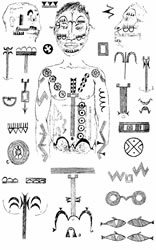
Fang tattoo designs, ca. 1907-1909. |
Ntum Fang elders interviewed by Sabater noted that in the distant past other tattoos were placed on small children to prevent their capture by the Pygmies (<em>bokui</em>) who were the original peoples of the equatorial forest. More specifically, these markings were said to have aided the Fang in identifying previously kidnapped boys and girls when they conducted their rescue operations.
Next Page | 1
|
2 | 3 |
4 |
5 |
6 |
7 |
8 |
Museum photo gallery of the images
on this page may be seen here. |





